CORNEA TECHNOLOGY CT1501 15-inch LCD Monitor User Manual
CORNEA TECHNOLOGY CO., LTD. 15-inch LCD Monitor Users Manual
Users Manual

REPORT NO : HCT-F01-1002 FCC ID :PL4CT1501 DATE : OCTOBER 12, 2001
HYUNDAI CALIBRATION & CERTIFICATION TECHNOLOGIES CO., LTD.
SAN 136-1, AMI-RI , BUBAL-EUP, ICHEON-SI,KYOUNGKI-DO, 467-701,KOREA
TEL : +82 31 639 8518 FAX : +82 31 639 8525 www.hctec.co.kr
ATTACHMENT E.
- User’s Manual.

REPORT NO : HCT-F01-1002 FCC ID :PL4CT1501 DATE : OCTOBER 12, 2001
HYUNDAI CALIBRATION & CERTIFICATION TECHNOLOGIES CO., LTD.
SAN 136-1, AMI-RI , BUBAL-EUP, ICHEON-SI,KYOUNGKI-DO, 467-701,KOREA
TEL : +82 31 639 8518 FAX : +82 31 639 8525 www.hctec.co.kr
LCD MONITOR
MODEL: CT1501
CORNEA TECHNOLOGY CO ., Ltd.

U.S.A.
U.S.FEDERAL COMMUNICATIONS COMMISSION
RADIO FREQUENCY INTERFERENCE STATEMENT
INFORMATION TO THE USER
NOTE : This equipment has been tested and found to comply with the limits for a
Class B digital device pursuant to Part 15 of the FCC Rules.
These limits are designed to provide reasonable protection against harmful
interference in a residential installation.
This equipment generates, uses, and can radiate radio frequency energy and, if
not installed and used in accordance with the instructions, may cause harmful
interference to radio communications.
However, there is no guarantee that interference will not occur in a particular
installation.
If this equipment does cause harmful interference to radio or television reception,
which can be determined by turning the equipment off and on, the user is
encouraged to try to correct the interference by one or more of the following
measures:
Reorient or relocate the receiving antenna.
Increase the separation between the equipment and receiver.
Connect the equipment into an outlet of a circuit different from that to which
the receiver is connected.
Consult the dealer or an experienced radio/TV technician for assistance.
Changes or modification not expressly approved by the party responsible for
compliance could void the user’s authority to operate the equipment.
Connecting of peripherals requires the use of grounded shielded signal cables.
TABLE OF CONTENTS
ADJUSTING YOUR LCD MONITOR --------------
2
• General safety precautions ………………….…………… 2
• Unpacking your monitor ………………………………… 5
• Viewing angle …………………………………………… 6
• Connecting your monitor …………………………… 7
• User controls ……………………………………………… 8
• OSD Functions and adjustments ……………….…..……… 9
• Menu adjustments …………………………….…..……… 10
• Refining the picture ………………………….…..……… 12
APPENDIX -----------------------------------
- 13
• Power management function …………….…..……..…… 13
• Video input terminal …………………………..……..… 13
• Display modes ……………………………….………… 14
• Troubleshooting ………………………………………… 15
• Specifications …………………………………………… 17

Adjusting your lcd monitor
2
General safety precautions
This Monitor has been engineered and manufactured to assure your safety. Please
read this manual and comply with the warnings and the procedures to avoid any
serious electrical shock and other serious damage.
1.
2.
3.
4.
Do not place anything heavy, wet or
magnetic on the monitor or power cord.
Do not cover the ventilation openings
nor touch them with metallic or
flammable material.
High temperature can cause troubles.
Avoid operating the monitor in extreme
heat, humidity or dusty areas. Extreme
temperature may cause discoloration or
damages.
Ambient Temperature : 0°C ~ 40°C
Do not use a solvent, such as benzene, to
clean the monitor to prevent any
damages to the LCD surface.
Do not use fine tools such as a pin or a
pencil near the monitor to prevent any
scratch to the LCD surface.

Adjusting your lcd monitor
3
5.
6.
7.
8.
Place the monitor on a flat surface to
prevent it from falling.
Do not apply any mechanical shocks to
the machine.
Install it in a well-ventilated area or
secure enough space for ventilation.
Turn the monitor off
before connecting it
to the power outlet.
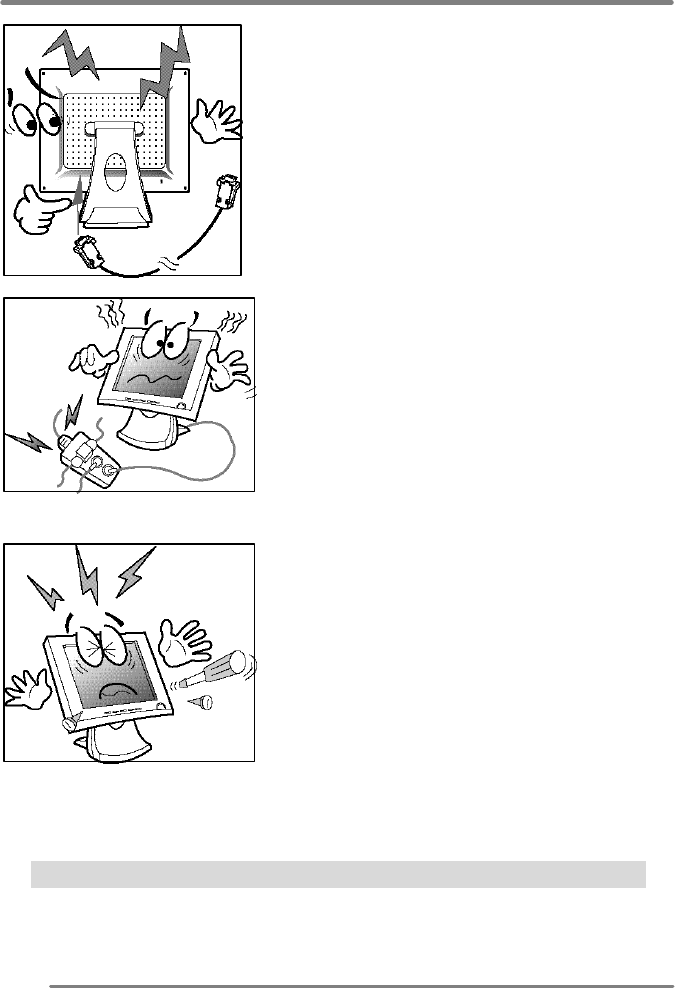
Adjusting your lcd monitor
4
CAUTION : RISK OF ELECTRIC SHOCK, DO NOT OPEN
9.
1
0
.
11.
Make sure that the power cord and the
other cords are properly connected.
Overloaded AC outlets and extension
cords are dangerous. Also, the frayed
power cords and the broken plugs may
cause electric shock or fire.
Do not open the monitor. There are no
user-serviceable components inside.
There is a risk of exposure to high-
voltage electricity inside, even when
power is turned off. If the display
monitor does not operate properly,
unplug the power cord and contact your
dealer. Handling the electrical
equipment carelessly will cause a
serious electrical shock and other
hazards.
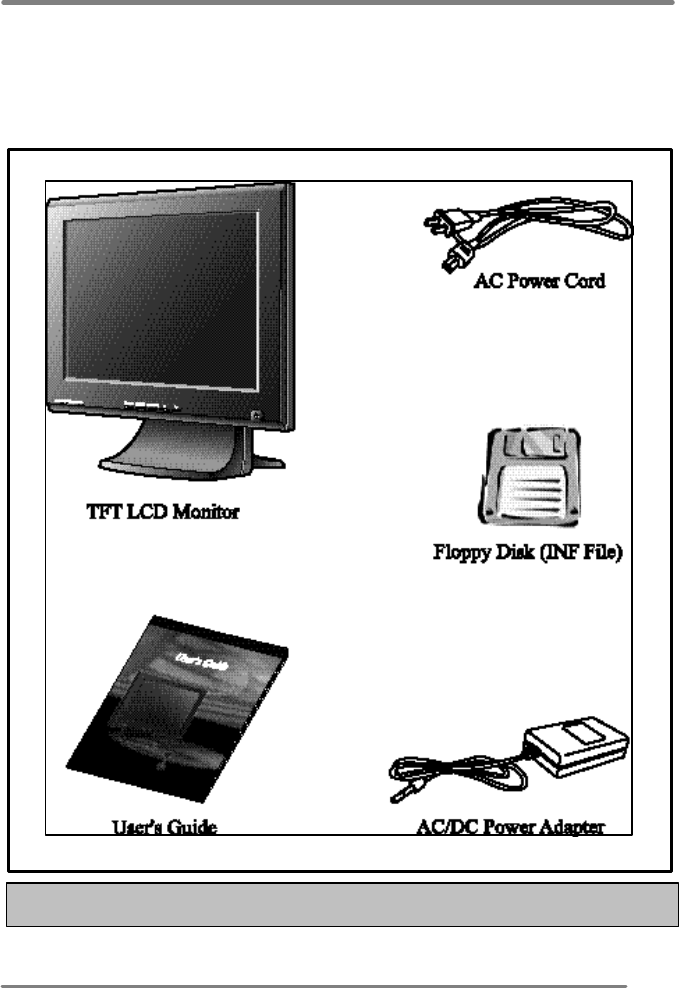
Adjusting your lcd monitor
5
Unpacking your monitor
Please make sure the following items are included with your monitor.
If you find that any of these items are missing or appear damaged, contact your
dealer immediately.
The power cord can be different depending upon different voltage areas.
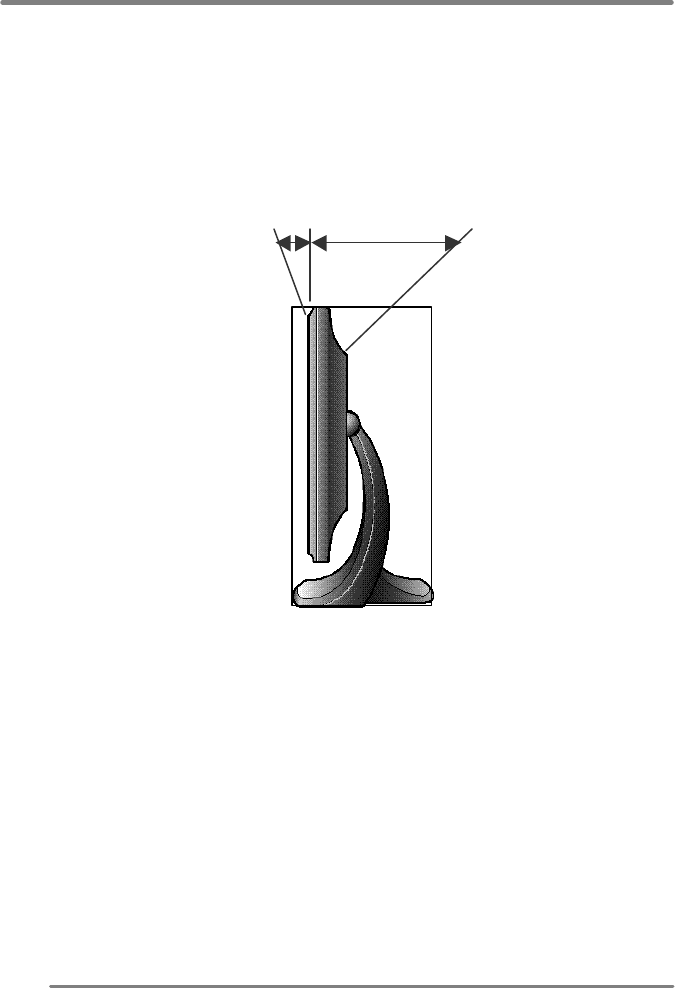
Adjusting your lcd monitor
6
Viewing angle
Your monitor was designed to allow you to adjust it to a comfortable viewing angle.
The viewing angle can be adjusted 6˚ to 60˚ forward and backward respectively as
indicated by the arrow marks below.
6? 60?
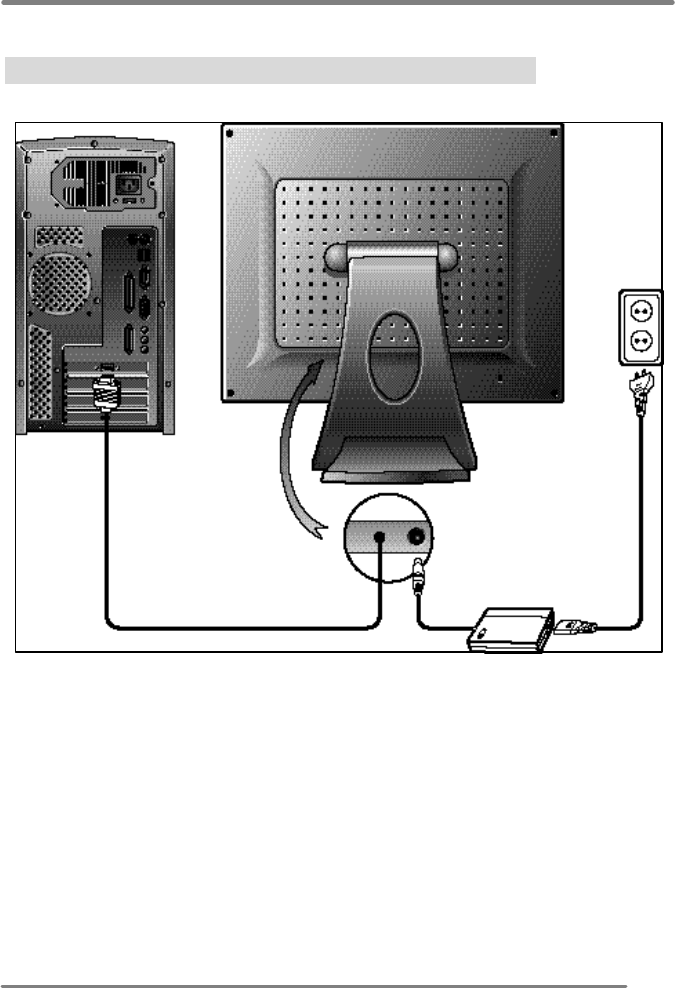
Adjusting your lcd monitor
7
Connecting your monitor
Be sure to turn the computer off before connecting the monitor
? Connect the power adaptor cord to the monitor and then to the power supply.
? After powering on the computer, adjust the display using the various controls
provided. For further information on the installation procedure, please refer to
the operating guide of the computer being used.
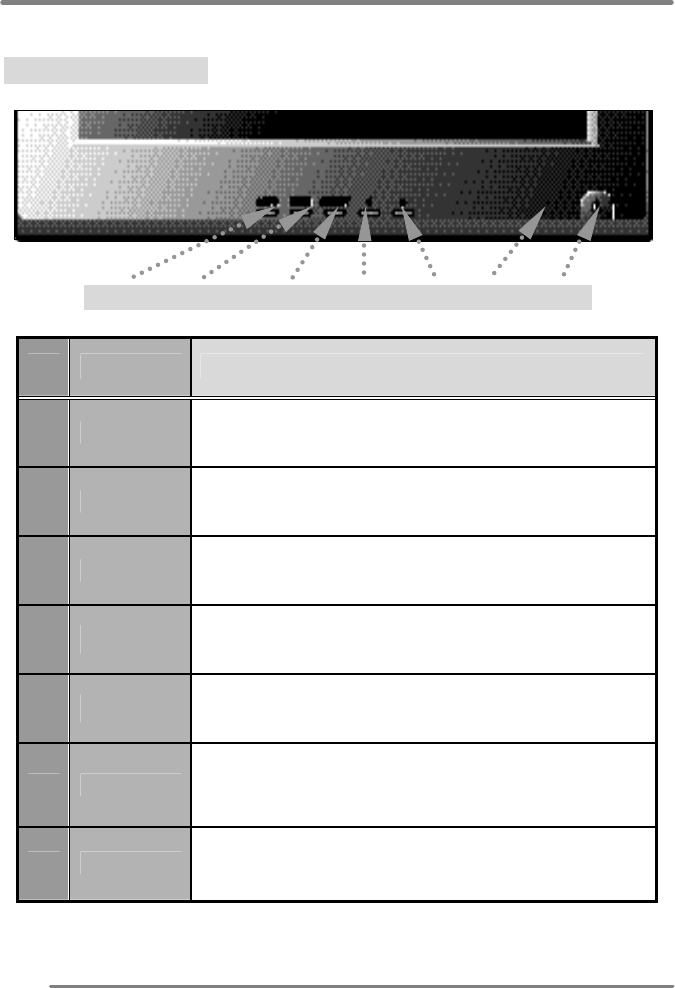
Adjusting your lcd monitor
8
User controls
Front control buttons
AUTO MENU SELECT DOWN UP LED POWER
No.
Key name
Description
1 AUTO Activates the auto adjustment function.
2 MENU Opens the OSD menu.
3 SELECT Selects the main menu items and sub-menu items.
4 ▼ Moves to the lower menu item or sub-menu item.
Decreases the value of the parameter.
5 ▲ Moves to the upper menu item or sub-menu item.
Increases the value of the parameter.
6 LED Indicates the status of the monitor.
• Green : Normal operation.
• Blinking : Power saving mode or disconnected signal cable.
7 POWER Turns on/off the monitor.

Adjusting your lcd monitor
9
OSD Functions and adjustments
Main menu and control selection
Press the MENU key to access the main menu.
Place the color box on the control icon you wish to adjust by
pressing using the ▼ or ▲ key.
Press the SELECT key to access the control.
Exit menu Press the MENU key to exit the OSD screen.
Auto exit The OSD menu will disappear automatically after a few second
of inactivity.
Auto save The monitor automatically saves the new values when OSD
closes.
Normal mode When the video signal is working in normal display mode,
power LED is lit green.
DPMS mode The LED indicates different status when this unit operates in
different power-saving modes.
Out of Range When an unsuitable signal is detected, the OSD d isplays an
Out of Range message.
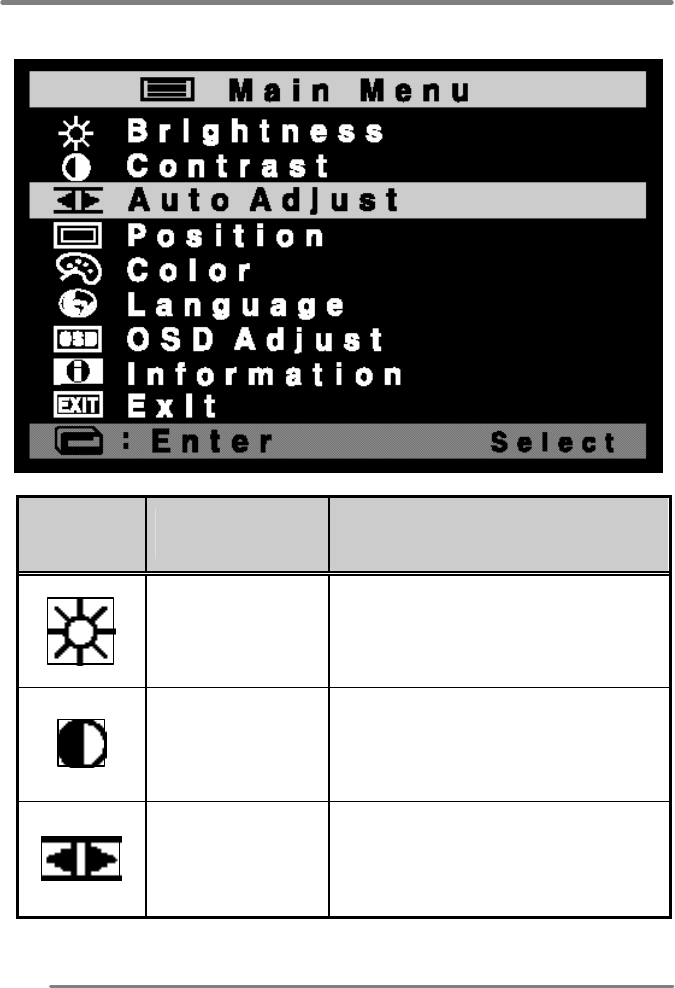
Adjusting your lcd monitor
10
Menu adjustments
Icon Settings and
sub-menus Description
BRIGHTNESS • Adjusts the screen intensity.
CONTRAST • Adjusts the contrast of the screen
image.
AUTO-ADJUST • Adjusts(automatically) the image
position, the clock and the phase
settings.
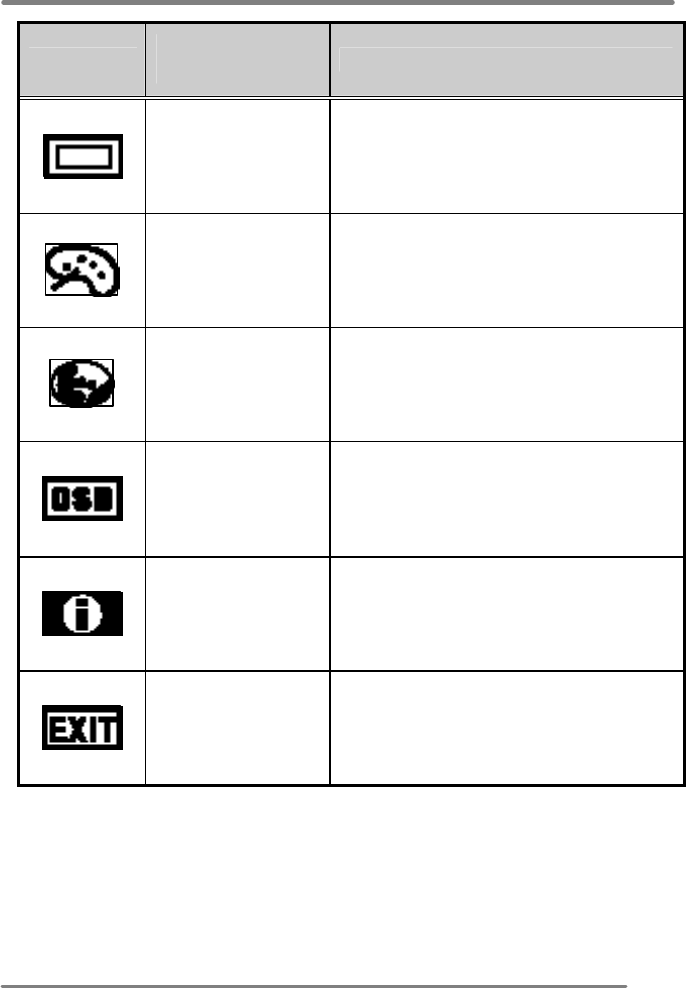
Adjusting your lcd monitor
11
Icon Settings and
sub-menus Description
POSITION • Adjusts the horizontal and vertical
position of the screen image.
COLOR • Displays the color control menu.
LANGUAGE • Selects from five languages.
OSD ADJUST • Displays the OSD position adjustment
for the OSD menu. Selects the OSD
display timing.
INFORMATION
• Information of input timing.
EXIT • Exits from menus and sub-menus.
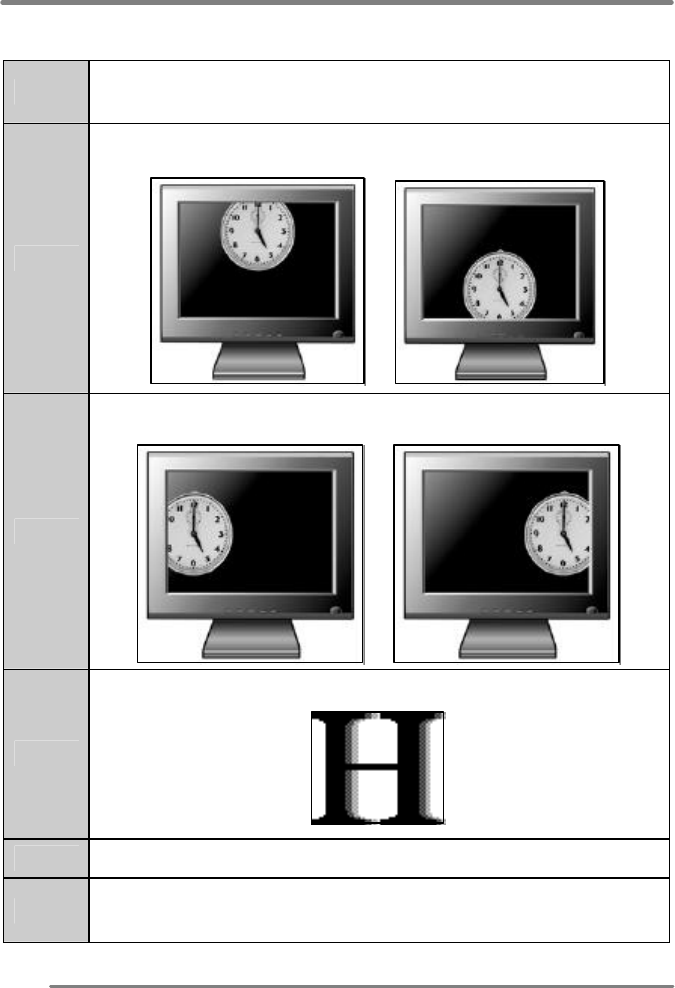
Adjusting your lcd monitor
12
Refining the picture
Step 1
At first display, a full screen, such as window background or "H"
character should be achieved by using editor.
Step 2
Adjust the screen to the center of the display (LCD), by using the top
and bottom display controls (i.e. using Vertical position menu).
Step 3
Adjust the screen to the center of the display (LCD) by using the right
and left display controls (i.e. using Horizontal position menu).
Step 4
Adjust the phase until the "H" character displays clear.
Step 5
Using the Contrast, Brightness, set the color to your preference.
Step 6
When you finish the adjustment, you can save your settings by
pressing on the menu until the OSD screen has disappeared.
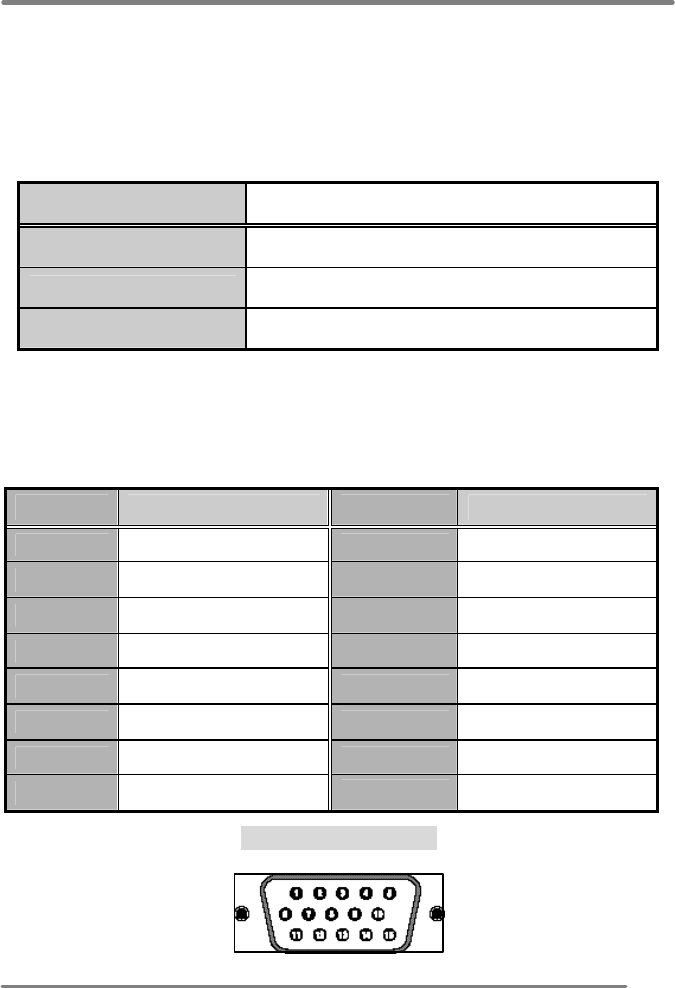
APPENDIX
13
Power management function
This monitor is equipped with a DPMS(Display Power Management Signaling)
function that automatically cuts the power dissipation down to less than 5W when
the computer is left unattended.
Although the monitor can be left in power-saving mode for longer periods, we
recommend that you turn it off after your daily work.
Status Description
Green Power on.
Blink (Amber/Green) Power saving.
Red Non operating / Abnormal operating.
Video input terminal
A 15Pin D-Sub connector is used as the input signal connector.
Each pin and assignment is shown in the table below.
Pin No. Signal Name Pin No. Signal Name
1 RED 9 N.C.
2 GREEN 10 GROUND
3 BLUE 11 GROUND
4 GROUND 12 DDC SDA
5 GROUND 13 H-Sync
6 RED Ground 14 V-Sync
7 GREEN Ground 15 DDC SCL
8 BLUE Ground
15Pin D-Sub connector

APPENDIX
14
Display modes
For the display modes listed below, the screen image has been optimized during
production.
Preset timing modes.
Mode
Display
Mode
Horizontal
Frequency (KHz)
Vertical
Frequency (Hz)
Standard Type
640 x 350 31.5KHz 70Hz IBM ?
720 x 400 31.5KHz 70Hz IBM ?
640 x 480 31.5KHz 60Hz Industry Standard
640 x 480 37.9KHz 72Hz VESA Standard
VGA
640 x 480 37.5KHz 75Hz VESA Standard
800 x 600 37.9KHz 60Hz VESA Guidelines
800 x 600 48.1KHz 72Hz VESA Standard
SVGA
800 x 600 46.9KHz 75Hz VESA Standard
1024 x 768 48.4KHz 60Hz VESA Guidelines
1024 x 768 56.5KHz 70Hz VESA Standard
XGA
1024 x 768 60.0KHz 75Hz VESA Standard
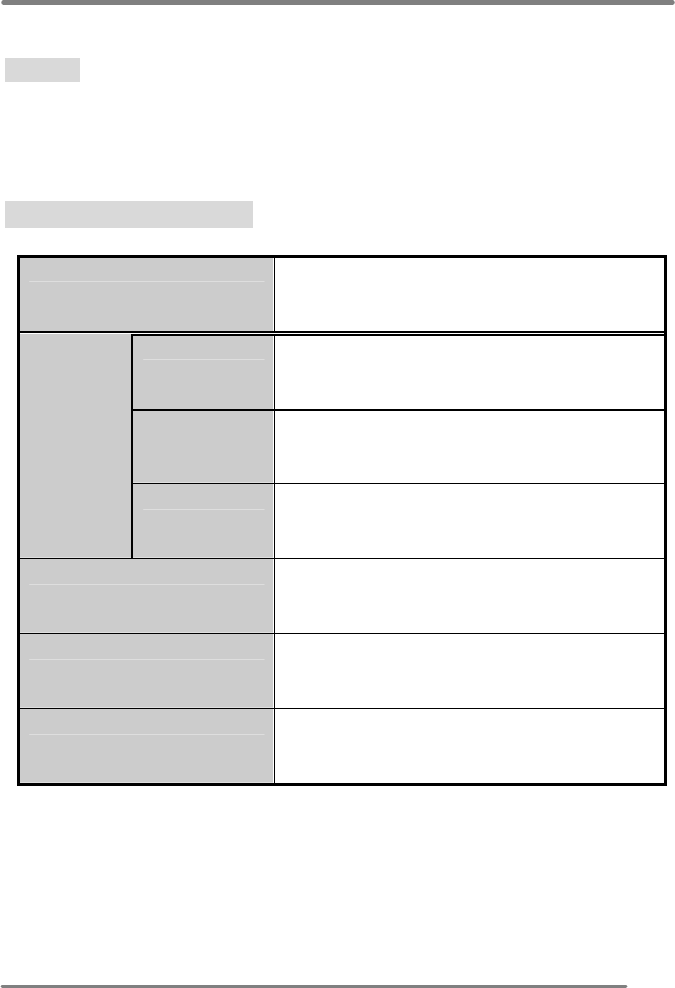
APPENDIX
15
Troubleshooting
Warning : This section will try to anticipate potential problems that you may
encounter in the day-to-day use of your monitor.
If after trying the suggested solutions, your monitor’s symptom
remains the same, contact your authorized service center.
Troubleshooting problems
Problems Corrective Actions
LED ON • Using OSD, adjust Brightness and Contrast to
maximum or reset to their default settings.
LED OFF • Check the power switch.
• Check if the AC power cord is properly
connected to the AC adapter.
No Picture
LED Blinking
• Check if video signal cable is properly
connected at the back of monitor.
• Check if the power to computer system is ON.
Display is not clear • Adjust the Frequency and Phase settings.
Too light or too dark • Adjust the Brightness and Contrast settings.
Image is not centered • Adjust the Horizontal and Vertical position
settings using the OSD.

APPENDIX
16
Problems Corrective Actions
Out of Range • Check the maximum resolution and the
frequency on the video port of your computer.
Picture is scrambled • Check the signal cable connection between
the computer and monitor.
Picture is fuzzy • Perform Auto adjustment.
Picture bounces or has
wavy oscillations • Check the signal cable connection between
computer and monitor.
Picture appears to be
ghosting • Check the signal cable connection between
computer and monitor.
Color is not uniform • Adjust the color settings using the color
menu.
The colors are distorted
with dark or shadowed
areas
• Adjust the color settings using the color
menu.
The power indicator is
blinking Amber
• The monitor is using its power management
system. Check the power management
utility on your computer.

APPENDIX
17
Specifications
Type • 15.0” viewable diagonal TFT type
Pixel
pitch • 0.297mm(H) x 0.297mm(V)
LCD
viewable
size Glass
surface • Anti-Glare, Hard Coating
Viewable angle • L/R : 60?, U/D : 35?/ 55?
Contrast ratio • 200:1 (typical)
Brightness • 200 cd/㎡(typical)
Response time • 40ms (Rising + Falling)
Resolution • 1024 x 768
Displayable color • 16.7M (Dithering)
Frame frequency
(Refresh rate) • Support range : 56 to 75Hz
• Recommended : 60Hz
User controls • Auto-Adjust, Brightness, Contrast, Position, Color,
Language, OSD Adjust
Plug & play • VESA DDC 1/2B
I/O Connectors • DC Power in, VGA 15-pin D-sub
Power •100~240V
Power consumption
(Typical) • 25W
AC/DC Adapter
• Input : Universal AC100 ~ 240V
• Output : DC 12V
• UL/cUL, CE, CB, TUV/GS, MPRII, FCC-B,
TCO 95, VCCI
Active area • 304.1mm(H) x 228.1mm(V)
Dimensions
(Physical) • 384.0mm(W) x 383.5mm(H) x 190.0mm(D)
Weight • 3.4Kg